Buran’s only flight
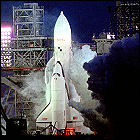 Modeled closely after the American Space Shuttle, the Soviet-built orbiter Buran lifts off for its first and only voyage into space. Still in the testing stages, Buran flies completely unmanned, with ground controllers at Baikonur Cosmodrome guiding the vehicle’s every move. With no large engines of its own (unlike NASA’s shuttle fleet), Buran is lifted into orbit solely by the giant Energia booster, makes two orbits, and returns home as a glider. A second flight is scheduled, but before it can take place, the Soviet Union collapses. Buran never flies again.
Modeled closely after the American Space Shuttle, the Soviet-built orbiter Buran lifts off for its first and only voyage into space. Still in the testing stages, Buran flies completely unmanned, with ground controllers at Baikonur Cosmodrome guiding the vehicle’s every move. With no large engines of its own (unlike NASA’s shuttle fleet), Buran is lifted into orbit solely by the giant Energia booster, makes two orbits, and returns home as a glider. A second flight is scheduled, but before it can take place, the Soviet Union collapses. Buran never flies again.
STS-26
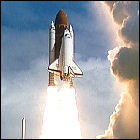 The first Space Shuttle launch in over two years since the Challenger accident, Discovery lifts off on a flight to test improved safety systems and procedures. The shuttle’s major payload is the second TDRS (Tracking & Data Relay Satellite) launched by NASA (an identical satellite was lost in the Challenger explosion in 1986), as well as numerous smaller experiments. Problems with Discovery’s environmental system cause the crew cabin to be warmer than usual. Discovery’s crew for this flight consists of Commander Fred Hauck, Pilot Richard Covey, and mission specialists John Lounge, George Nelson, and David Hilmers.
The first Space Shuttle launch in over two years since the Challenger accident, Discovery lifts off on a flight to test improved safety systems and procedures. The shuttle’s major payload is the second TDRS (Tracking & Data Relay Satellite) launched by NASA (an identical satellite was lost in the Challenger explosion in 1986), as well as numerous smaller experiments. Problems with Discovery’s environmental system cause the crew cabin to be warmer than usual. Discovery’s crew for this flight consists of Commander Fred Hauck, Pilot Richard Covey, and mission specialists John Lounge, George Nelson, and David Hilmers.
Did you go before leaving the space station?
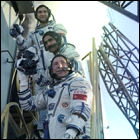 Cosmonauts Vladimir Lyakhov and Abdul Ahad Mohmand, the first Afghan in space, undock from the Mir space station and prepare to return home, jettisoning the orbital module of their Soyuz TM-5 space capsule per standard procedure. But their descent module – the only part of a Soyuz that ever returns to Earth intact – experiences numerous technical glitches, and ground controllers in the Soviet Union order them to stay in orbit for an extra day. That’s easy enough for engineers on Earth to say: the abandoned orbital module contains the only toilet facilities on a Soyuz spacecraft, leaving the crew to hold everything until their return on September 7th; there is also no fresh water available. Needless to say, Soviet mission planners redraw the rules of future missions to keep the orbital module attached until the last possible moment with safety guidelines.
Cosmonauts Vladimir Lyakhov and Abdul Ahad Mohmand, the first Afghan in space, undock from the Mir space station and prepare to return home, jettisoning the orbital module of their Soyuz TM-5 space capsule per standard procedure. But their descent module – the only part of a Soyuz that ever returns to Earth intact – experiences numerous technical glitches, and ground controllers in the Soviet Union order them to stay in orbit for an extra day. That’s easy enough for engineers on Earth to say: the abandoned orbital module contains the only toilet facilities on a Soyuz spacecraft, leaving the crew to hold everything until their return on September 7th; there is also no fresh water available. Needless to say, Soviet mission planners redraw the rules of future missions to keep the orbital module attached until the last possible moment with safety guidelines.
Soyuz TM-6
 The Soviet Union launches the Soyuz TM-6 mission to the Mir space station, with cosmonauts Vladimir Lyakhov, Valeri Polyakov and Abdul Ahad Mohmand aboard. Lyakhov and Mohmand remain aboard Mir for only a week, participating in experiments involving both crews, but Polyakov, a medical doctor, remains on Mir to monitor the Expedition 3 crew in the final months of their unprecedented one-year stay in orbit. This crew exchanges spacecraft with the station crew, returning home in the Soyuz TM-5 vehicle after a week on Mir, but their return is plagued by problems both technical and otherwise.
The Soviet Union launches the Soyuz TM-6 mission to the Mir space station, with cosmonauts Vladimir Lyakhov, Valeri Polyakov and Abdul Ahad Mohmand aboard. Lyakhov and Mohmand remain aboard Mir for only a week, participating in experiments involving both crews, but Polyakov, a medical doctor, remains on Mir to monitor the Expedition 3 crew in the final months of their unprecedented one-year stay in orbit. This crew exchanges spacecraft with the station crew, returning home in the Soyuz TM-5 vehicle after a week on Mir, but their return is plagued by problems both technical and otherwise.
Soyuz TM-5
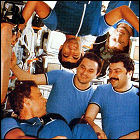 Cosmonauts Anatoly Solovyev, Viktor Savinykh and Aleksandr Aleksandrov lift off for a week-long visit to Soviet space station Mir aboard Soyuz TM-5. Numerous biological and astronomical experiments are conducted by the blended crew, and at the end of the week of joint activities, the Soyuz TM-5 crew use the older TM-4 capsule to return home, leaving the station crew with a newer vehicle.
Cosmonauts Anatoly Solovyev, Viktor Savinykh and Aleksandr Aleksandrov lift off for a week-long visit to Soviet space station Mir aboard Soyuz TM-5. Numerous biological and astronomical experiments are conducted by the blended crew, and at the end of the week of joint activities, the Soyuz TM-5 crew use the older TM-4 capsule to return home, leaving the station crew with a newer vehicle.
Soyuz TM-4 / Mir Expedition 3
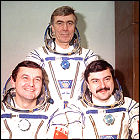 The Soyuz TM-4 mission is launched by the Soviet Union, en route to space station Mir. Cosmonauts Vladimir Titov and Musa Manarov take up residence as the new long-duration crew aboard Mir, formally known as Expedition 3, and they eventually break all previous space endurance records by staying aboard Mir for exactly one year and one day, returning to Earth on December 21st, 1988. Cosmonaut Anatoli Levchenko, after the week-long overlap with the Expedition 2 crew, returns to Earth with Expedition 2 crew members Yuri Romanenko and Aleksandr Aleksandrov aboard the Soyuz TM-3 vehicle.
The Soyuz TM-4 mission is launched by the Soviet Union, en route to space station Mir. Cosmonauts Vladimir Titov and Musa Manarov take up residence as the new long-duration crew aboard Mir, formally known as Expedition 3, and they eventually break all previous space endurance records by staying aboard Mir for exactly one year and one day, returning to Earth on December 21st, 1988. Cosmonaut Anatoli Levchenko, after the week-long overlap with the Expedition 2 crew, returns to Earth with Expedition 2 crew members Yuri Romanenko and Aleksandr Aleksandrov aboard the Soyuz TM-3 vehicle.
Soyuz TM-3
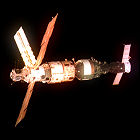 The Soviet Union launches Soyuz TM-3 on an eight-day mission into space which includes a visit to space station Mir. Cosmonauts Aleksandr Aleksandrov and Muhammed Faris (the latter of whom is the first Syrian space traveler) return to Earth at the end of the mission, along with Mir crew member Yuri Romanenko, while Alexander Viktorenko takes Romanenko’s slot on Mir. In order to leave the newer vehicle docked to Mir as an escape craft, the Soyuz TM-3 crew returns aboard Soyuz TM-2.
The Soviet Union launches Soyuz TM-3 on an eight-day mission into space which includes a visit to space station Mir. Cosmonauts Aleksandr Aleksandrov and Muhammed Faris (the latter of whom is the first Syrian space traveler) return to Earth at the end of the mission, along with Mir crew member Yuri Romanenko, while Alexander Viktorenko takes Romanenko’s slot on Mir. In order to leave the newer vehicle docked to Mir as an escape craft, the Soyuz TM-3 crew returns aboard Soyuz TM-2.
Space Station Freedom’s new mission
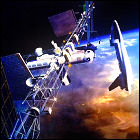 President Reagan approves a $10,000,000,000 budget for a redesigned, pared-down Space Station Freedom, to be constructed over sixteen Space Shuttle launches beginning in 1994, with Freedom not being fully operational until 1996. To the stern disapproval of the scientific community, almost all laboratory space has been removed from Freedom’s design proposal, leaving only Japan and the European Space Agency to provide lab space. Without the space for American astronauts to conduct scientific experiments, Space Station Freedom’s new primary mission is quite clearly stated to be to catch the American space program up with, or surpass, the Soviet Union’s long-duration space missions aboard the Mir space station. While the Preisdent approves of the slimmed-down station design, NASA must now run the gauntlet to get Congressional approval to proceed.
President Reagan approves a $10,000,000,000 budget for a redesigned, pared-down Space Station Freedom, to be constructed over sixteen Space Shuttle launches beginning in 1994, with Freedom not being fully operational until 1996. To the stern disapproval of the scientific community, almost all laboratory space has been removed from Freedom’s design proposal, leaving only Japan and the European Space Agency to provide lab space. Without the space for American astronauts to conduct scientific experiments, Space Station Freedom’s new primary mission is quite clearly stated to be to catch the American space program up with, or surpass, the Soviet Union’s long-duration space missions aboard the Mir space station. While the Preisdent approves of the slimmed-down station design, NASA must now run the gauntlet to get Congressional approval to proceed.
Kvant-1: Mir expands
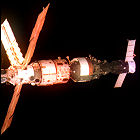 The Soviet Union launches the first Kvant module to join with the Mir core module. An expansion originally devised for the Salyut 7 space station, Kvant provides additional working space and life support systems aboard Mir as, well as a gyroscopic stablization system to keep the station properly oriented without the constant use of engines and fuel. Years later, the basic Kvant design will be developed further in Russia’s contributions to the International Space Station.
The Soviet Union launches the first Kvant module to join with the Mir core module. An expansion originally devised for the Salyut 7 space station, Kvant provides additional working space and life support systems aboard Mir as, well as a gyroscopic stablization system to keep the station properly oriented without the constant use of engines and fuel. Years later, the basic Kvant design will be developed further in Russia’s contributions to the International Space Station.
Soyuz TM-2 / Mir Expedition 2
 The Soviet Union launches Soyuz TM-2, the first manned launch of a newly uprated version of the Soyuz capsule. Cosmonauts Yuri Romanenko and Aleksandr Laveykin travel to the Mir space station, where Laveykin remains for 174 days before departing in July, but Romanenko sets a new space endurance record, remaining in orbit for 326 days. Romanenko’s return to Earth just before the end of 1987 marks the end of Expedition 2’s occupancy of Mir.
The Soviet Union launches Soyuz TM-2, the first manned launch of a newly uprated version of the Soyuz capsule. Cosmonauts Yuri Romanenko and Aleksandr Laveykin travel to the Mir space station, where Laveykin remains for 174 days before departing in July, but Romanenko sets a new space endurance record, remaining in orbit for 326 days. Romanenko’s return to Earth just before the end of 1987 marks the end of Expedition 2’s occupancy of Mir.
Soyuz T-15 / Mir Expedition 1
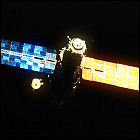 The Soviet Union launches Soyuz T-15 on an unprecedented mission into orbit. Cosmonauts Leonid Kizim and Vladimir Solovyov become the first occupants of the newly-launched Mir space station on March 15th, where they remain until early May, at which time they undock the Soyuz T-15 vehicle from Mir and visit the powered-down Salyut 7 space station, becoming its final occupants until they return to Mir in late June, bringing several pieces of equipment and experiments cannibalized from Salyut back with them. The crew spends a total of 125 days in space, at the end of which Kizim is the most-traveled man in space, having accumulated over a year of total space travel time. Soyut T-15 is the last second-generation Soyuz vehicle to fly, returning to Earth on July 16th.
The Soviet Union launches Soyuz T-15 on an unprecedented mission into orbit. Cosmonauts Leonid Kizim and Vladimir Solovyov become the first occupants of the newly-launched Mir space station on March 15th, where they remain until early May, at which time they undock the Soyuz T-15 vehicle from Mir and visit the powered-down Salyut 7 space station, becoming its final occupants until they return to Mir in late June, bringing several pieces of equipment and experiments cannibalized from Salyut back with them. The crew spends a total of 125 days in space, at the end of which Kizim is the most-traveled man in space, having accumulated over a year of total space travel time. Soyut T-15 is the last second-generation Soyuz vehicle to fly, returning to Earth on July 16th.
Mir
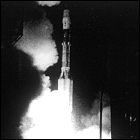 The Soviet Union launches the first module of its new Mir space station, a new modular station design building on the Soviets’ years of experience with the Salyut stations. One end of this “core” module is a six-sided structure, with docking ports on five sides; this design will allow new modules to be added onto Mir in all directions, and will potentially allow for several Soyuz or unmanned Progress cargo vehicles to be docked simultaneously, a design element which will later be carried forward to the International Space Station.
The Soviet Union launches the first module of its new Mir space station, a new modular station design building on the Soviets’ years of experience with the Salyut stations. One end of this “core” module is a six-sided structure, with docking ports on five sides; this design will allow new modules to be added onto Mir in all directions, and will potentially allow for several Soyuz or unmanned Progress cargo vehicles to be docked simultaneously, a design element which will later be carried forward to the International Space Station.
STS-51L: the Challenger disaster
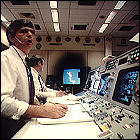 73 seconds after liftoff, Space Shuttle Challenger explodes when a rubber O-ring designed to be a tight seal between solid rocket booster segments allows flames from the booster to breach the shuttle’s external fuel tank, causing the tank’s highly flammable contents to ignite. The shuttle is destroyed with all hands aboard. Later analysis reveals that frigid cold temperatures in the nights leading up to the launch allowed the booster’s O-rings to become brittle enough to break – a possibility that NASA had been warned of by engineers at Morton-Thiokol, the contractor responsible for the solid rocket boosters.
73 seconds after liftoff, Space Shuttle Challenger explodes when a rubber O-ring designed to be a tight seal between solid rocket booster segments allows flames from the booster to breach the shuttle’s external fuel tank, causing the tank’s highly flammable contents to ignite. The shuttle is destroyed with all hands aboard. Later analysis reveals that frigid cold temperatures in the nights leading up to the launch allowed the booster’s O-rings to become brittle enough to break – a possibility that NASA had been warned of by engineers at Morton-Thiokol, the contractor responsible for the solid rocket boosters.
Lost in the explosion are Commander Francis R. Scobee, Pilot Michael Smith, mission specialists Judy Resnik, Ellison Onizuka and Ronald McNair, and payload specialists Gregory Jarvis and Christa McAuliffe, the highly-publicized first “teacher in space.”
The Space Shuttle program is grounded for over two years during an investigation and an extensive review of safety and launch procedures.
STS-61C
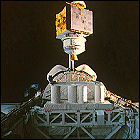 Space Shuttle Columbia lifts off on a six-day satellite deployment mission, and is also the first spaceflight to include a sitting member of the US Congress among its crew. The SATCOM KU-I satellite is launched, but another payload designed to observe Halley’s Comet (which is rapidly approaching its closest approach to Earth) malfunctions and collects no data. Columbia’s crew for this mission consists of Commander Robert Gibson, Pilot Charles Bolden, mission specialists Franklin Chang-Diaz, Steven Hawley, George Nelson, and payload specialists Robert Cenker and Congressman Bill Nelson.
Space Shuttle Columbia lifts off on a six-day satellite deployment mission, and is also the first spaceflight to include a sitting member of the US Congress among its crew. The SATCOM KU-I satellite is launched, but another payload designed to observe Halley’s Comet (which is rapidly approaching its closest approach to Earth) malfunctions and collects no data. Columbia’s crew for this mission consists of Commander Robert Gibson, Pilot Charles Bolden, mission specialists Franklin Chang-Diaz, Steven Hawley, George Nelson, and payload specialists Robert Cenker and Congressman Bill Nelson.
This is the final successful shuttle flight until 1988.
STS-61B
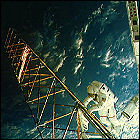 Space Shuttle Atlantis lifts off on a seven-day mission of crucial importance to plans for a future space station. In addition to launching three satellites (Mexico’s MORELOS-B, RCA’s SATCOM KU-2 and AUSSAT-2 for Australia), two spacewalks in excess of five hours each are conducted, each one testing a different method of erecting large truss structures in space. Atlantis’ crew for this mission consists of Commander Brewster Shaw, Pilot Bryan O’Connor, mission specialists Mary Cleave, Sherwood Spring, Jerry Ross and payload specialists Rodolfo Neri Vela and Charles Walker.
Space Shuttle Atlantis lifts off on a seven-day mission of crucial importance to plans for a future space station. In addition to launching three satellites (Mexico’s MORELOS-B, RCA’s SATCOM KU-2 and AUSSAT-2 for Australia), two spacewalks in excess of five hours each are conducted, each one testing a different method of erecting large truss structures in space. Atlantis’ crew for this mission consists of Commander Brewster Shaw, Pilot Bryan O’Connor, mission specialists Mary Cleave, Sherwood Spring, Jerry Ross and payload specialists Rodolfo Neri Vela and Charles Walker.
Enterprise retired
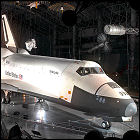 The Space Shuttle Enterprise arrives to begin its new life as a star exhibit at the Smithsonian Air & Space Museum in Washington D.C. Having used the Enterprise as a test shuttle for landings and engineering fit checks, and having dispatched it on a world tour of air shows and other public appearances, NASA donates Enterprise to the Smithsonian, as any plans to refit it into a spaceworthy orbiter have been nixed by this point.
The Space Shuttle Enterprise arrives to begin its new life as a star exhibit at the Smithsonian Air & Space Museum in Washington D.C. Having used the Enterprise as a test shuttle for landings and engineering fit checks, and having dispatched it on a world tour of air shows and other public appearances, NASA donates Enterprise to the Smithsonian, as any plans to refit it into a spaceworthy orbiter have been nixed by this point.
Buran Approach & Landing Test 1
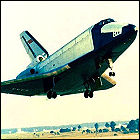 With its own jet engines freeing it from the need for a carrier aircraft, the Buran Analogue test vehicle – the Soviet equivalent of Space Shuttle Enterprise – makes its first approach and landing test, cutting off its jet engines at a predetermined altitude and gliding to an airstrip for a landing. The Buran Analogue will ultimately make more test flights than the Enterprise, continuing to conduct glider landings through 1988.
With its own jet engines freeing it from the need for a carrier aircraft, the Buran Analogue test vehicle – the Soviet equivalent of Space Shuttle Enterprise – makes its first approach and landing test, cutting off its jet engines at a predetermined altitude and gliding to an airstrip for a landing. The Buran Analogue will ultimately make more test flights than the Enterprise, continuing to conduct glider landings through 1988.
STS-61A
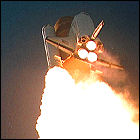 Space Shuttle Challenger lifts off on a one-week mission to carry the Spacelab module and an all-German crew to orbit. The “Spacelab D1” mission is flown by Commander Henry Hartsfield, Pilot Steven Nagel, mission specialists James Buchli, Guion Bluford, and Bonnie Dunbar, and payload specialists Reinhard Furrer, Ernst Messerschmid and Wubbo J. Ockels.
Space Shuttle Challenger lifts off on a one-week mission to carry the Spacelab module and an all-German crew to orbit. The “Spacelab D1” mission is flown by Commander Henry Hartsfield, Pilot Steven Nagel, mission specialists James Buchli, Guion Bluford, and Bonnie Dunbar, and payload specialists Reinhard Furrer, Ernst Messerschmid and Wubbo J. Ockels.
This is the final successful launch of Challenger.
Vandenberg shuttle launch pad ready
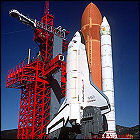 With $4 billion having been spent on upgrading and customizing a special launch facility since 1972 to handle (mostly military) Space Shuttle launches in polar orbits, Vandenberg AFB declares Space Launch Complex 6 launch-ready, with a year to go before the first scheduled polar orbit shuttle launch. But in 1986, amid jitters in the wake of the Challenger disaster, planned use of the west coast launch facility is curtailed and finally cancelled, despite the money and time spent.
With $4 billion having been spent on upgrading and customizing a special launch facility since 1972 to handle (mostly military) Space Shuttle launches in polar orbits, Vandenberg AFB declares Space Launch Complex 6 launch-ready, with a year to go before the first scheduled polar orbit shuttle launch. But in 1986, amid jitters in the wake of the Challenger disaster, planned use of the west coast launch facility is curtailed and finally cancelled, despite the money and time spent.
STS-51J: the first flight of Atlantis
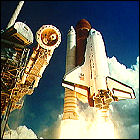 The inaugural flight of Space Shuttle Atlantis takes the newest orbiter on a four-day Defense Department mission (the specifics of which remain classified). Manning Atlantis for this flight are Commander Karol Bobko, Pilot Ronald Grabe, and mission specialists David Hilmers, Robert Stewart and William Pailes.
The inaugural flight of Space Shuttle Atlantis takes the newest orbiter on a four-day Defense Department mission (the specifics of which remain classified). Manning Atlantis for this flight are Commander Karol Bobko, Pilot Ronald Grabe, and mission specialists David Hilmers, Robert Stewart and William Pailes.
Kosmos 1686: expanding Salyut 7
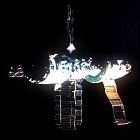 The unmanned Kosmos 1686 module, launched by the Soviet Union in September, successfully completes an automated docking with space station Salyut 7. This new module is a permanent addition to the final Salyut station, offering more habitable space for work and storage aboard the aging station. Kosmos 1686 arrives with nearly 10,000 pounds of supplies and consumables, and serves as a case study to help engineers plan the upcoming Mir space station, which is designed from the outset to consist of several add-on modules.
The unmanned Kosmos 1686 module, launched by the Soviet Union in September, successfully completes an automated docking with space station Salyut 7. This new module is a permanent addition to the final Salyut station, offering more habitable space for work and storage aboard the aging station. Kosmos 1686 arrives with nearly 10,000 pounds of supplies and consumables, and serves as a case study to help engineers plan the upcoming Mir space station, which is designed from the outset to consist of several add-on modules.
Soyuz T-14
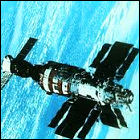 The Soviet Union launches the Soyuz T-14 mission, carrying a crew of three cosmonauts intended to become the next long-term occupants of space station Salyut 7. The crew consists of Vladimir Vasyutin, Georgi Grechko and Alexander Volkov, though Grechko only remains until September 26th, returning to Earth with the Soyuz T-13 crew. Two months into the crew’s stay on Salyut, however, Vasyutin becomes seriously ill. Communications between the station and ground controllers are carried out on a scrambled frequency for a week, at which point the crew is recalled to Earth, ending an occupancy that was meant to last for half a year. Soyuz T-14 returns to Earth, carring Vasyutin, Volkov and Soyuz T-13 crew member Viktor Savinykh home on November 21st, once again leaving Salyut 7 unoccupied for several months.
The Soviet Union launches the Soyuz T-14 mission, carrying a crew of three cosmonauts intended to become the next long-term occupants of space station Salyut 7. The crew consists of Vladimir Vasyutin, Georgi Grechko and Alexander Volkov, though Grechko only remains until September 26th, returning to Earth with the Soyuz T-13 crew. Two months into the crew’s stay on Salyut, however, Vasyutin becomes seriously ill. Communications between the station and ground controllers are carried out on a scrambled frequency for a week, at which point the crew is recalled to Earth, ending an occupancy that was meant to last for half a year. Soyuz T-14 returns to Earth, carring Vasyutin, Volkov and Soyuz T-13 crew member Viktor Savinykh home on November 21st, once again leaving Salyut 7 unoccupied for several months.
STS-51I
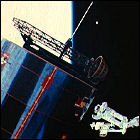 Space Shuttle Discovery lifts off on a mission to deliver three communications satellites to orbit. The triple payload includes SYNCOM IV-4, the Australian AUSSAT-1 satellite, and American Satellite Company’s ASC-1. Discovery is manned on this mission by Commander Joe Engle, Pilot Richard Covey, and mission specialists James van Hoften, John Lounge and William Fisher. The mission lasts one week, and Discovery is able to return home a day early after achieving mission objectives ahead of time.
Space Shuttle Discovery lifts off on a mission to deliver three communications satellites to orbit. The triple payload includes SYNCOM IV-4, the Australian AUSSAT-1 satellite, and American Satellite Company’s ASC-1. Discovery is manned on this mission by Commander Joe Engle, Pilot Richard Covey, and mission specialists James van Hoften, John Lounge and William Fisher. The mission lasts one week, and Discovery is able to return home a day early after achieving mission objectives ahead of time.
STS-51F: Challenger aborts to orbit
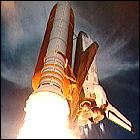 For the first and only time in the history of the shuttle program, Space Shuttle Challenger does an in-flight abort maneuver – in this case, an Abort To Orbit (ATO) following the premature shutdown of one of the shuttle’s main engines. The potentially catastrophic shutdown of a second engine is narrowly avoided by a sharp-eyed ground controller, and Challenger makes it to orbit and the rest of the mission is conducted normally.
For the first and only time in the history of the shuttle program, Space Shuttle Challenger does an in-flight abort maneuver – in this case, an Abort To Orbit (ATO) following the premature shutdown of one of the shuttle’s main engines. The potentially catastrophic shutdown of a second engine is narrowly avoided by a sharp-eyed ground controller, and Challenger makes it to orbit and the rest of the mission is conducted normally.
STS-51G
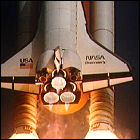 Space Shuttle Discovery returns to orbit for a week-long flight including the deployment of three communications satellites. American, Mexican and Saudi Arabian satellites are launched via payload assist modules. Discovery crew consists of Commander Daniel Brandenstein, Pilot John Creighton, mission specialists Shannon Lucid, John Fabian and Steven Nagel, and payload specialists Patrick Baudry and Sultan Salman Al-Saud (the first Saudi Arabian national to fly in space).
Space Shuttle Discovery returns to orbit for a week-long flight including the deployment of three communications satellites. American, Mexican and Saudi Arabian satellites are launched via payload assist modules. Discovery crew consists of Commander Daniel Brandenstein, Pilot John Creighton, mission specialists Shannon Lucid, John Fabian and Steven Nagel, and payload specialists Patrick Baudry and Sultan Salman Al-Saud (the first Saudi Arabian national to fly in space).
Soyuz T-13: saving Salyut 7
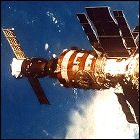 The Soviet Union launches Soyuz T-13 on a mission to salvage space station Salyut 7, which has gone unoccupied for more than half a year and has lost power and attitude control. Cosmonauts Vladimir Dzhanibekov and Viktor Savinykh find the station dead in space, tumbling slowly, forcing them to use their Soyuz vehicle’s thrusters to match the station’s erratic motion to allow a manual docking. Inside the station, the crew finds frigid but breathable air, and again the Soyuz engines are fired to orient the station so its solar panels catch enough sunlight to charge its batteries. After a week of work carried out in bulky clothing befitting a Russian winter, the cosmonauts reactivate the station fully, scoring a major space first – the first-ever docking with, and repair of, a fully deactivated space station. For the first time, a Salyut crew spends some overlap time with the next long-term crew, a step toward the uninterrupted occupancy that will become commonplace aboard Mir, Salyut’s successor. Savinykh remains aboard Salyut 7 for 168 days, overlapping into the next long-term station crew, while Dzhanibekov departs 110 days into his stay.
The Soviet Union launches Soyuz T-13 on a mission to salvage space station Salyut 7, which has gone unoccupied for more than half a year and has lost power and attitude control. Cosmonauts Vladimir Dzhanibekov and Viktor Savinykh find the station dead in space, tumbling slowly, forcing them to use their Soyuz vehicle’s thrusters to match the station’s erratic motion to allow a manual docking. Inside the station, the crew finds frigid but breathable air, and again the Soyuz engines are fired to orient the station so its solar panels catch enough sunlight to charge its batteries. After a week of work carried out in bulky clothing befitting a Russian winter, the cosmonauts reactivate the station fully, scoring a major space first – the first-ever docking with, and repair of, a fully deactivated space station. For the first time, a Salyut crew spends some overlap time with the next long-term crew, a step toward the uninterrupted occupancy that will become commonplace aboard Mir, Salyut’s successor. Savinykh remains aboard Salyut 7 for 168 days, overlapping into the next long-term station crew, while Dzhanibekov departs 110 days into his stay.
STS-51B
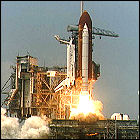 Space Shuttle Challenger lifts off on a week-long mission to perform experiments in the cargo-bay-mounted Spacelab laboratory module. Aboard Challenger for the Spacelab 3 flight are Commander Robert Overmyer, Pilot Frederick Gregory, mission specialists Don Lind, Norm Thagard, and William Thornton, and payload specialists Lodewijk van den Berg and Taylor Wang. Following the landing gear damage experienced by Discovery on its last flight, Challenger makes its landing at Edwards Air Force Base.
Space Shuttle Challenger lifts off on a week-long mission to perform experiments in the cargo-bay-mounted Spacelab laboratory module. Aboard Challenger for the Spacelab 3 flight are Commander Robert Overmyer, Pilot Frederick Gregory, mission specialists Don Lind, Norm Thagard, and William Thornton, and payload specialists Lodewijk van den Berg and Taylor Wang. Following the landing gear damage experienced by Discovery on its last flight, Challenger makes its landing at Edwards Air Force Base.
STS-51D
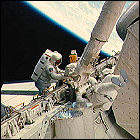 After a month of delays due to damage and a change in the flight schedule, Space Shuttle Discovery returns to orbit for a week-long flight. A Canadian communications satellite and the LEASAT-3 satellite are redeployed, but LEASAT continues to malfunction despite multiple attempts to active and launch it. Discovery’s crew on this flight consists of Commander Karol Bobko, Pilot Donald Williams, mission specialists Rhea Seddon, Jeffrey Hoffman and David Griggs, and payload specialists Charles Walker and Senator Jake Garn, the first member of the U.S. Congress to fly in space while in office. This flight’s return to the runway at Kennedy Space Center marks the first time a shuttle orbiter experiences significant damage upon landing, including a blowout of one of its landing gear wheels.
After a month of delays due to damage and a change in the flight schedule, Space Shuttle Discovery returns to orbit for a week-long flight. A Canadian communications satellite and the LEASAT-3 satellite are redeployed, but LEASAT continues to malfunction despite multiple attempts to active and launch it. Discovery’s crew on this flight consists of Commander Karol Bobko, Pilot Donald Williams, mission specialists Rhea Seddon, Jeffrey Hoffman and David Griggs, and payload specialists Charles Walker and Senator Jake Garn, the first member of the U.S. Congress to fly in space while in office. This flight’s return to the runway at Kennedy Space Center marks the first time a shuttle orbiter experiences significant damage upon landing, including a blowout of one of its landing gear wheels.
Atlantis complete
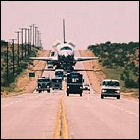 After four years of construction and an additional year of testing and checkout, the Space Shuttle Atlantis rolls out of the Rockwell International facility at Palmdale, California – the last of the current space shuttle fleet, to the best of anyone’s knowledge at the time. Over three tons lighter than Columbia, Atlantis doesn’t have long to wait for her first mission, lifting off for the first time in October 1985.
After four years of construction and an additional year of testing and checkout, the Space Shuttle Atlantis rolls out of the Rockwell International facility at Palmdale, California – the last of the current space shuttle fleet, to the best of anyone’s knowledge at the time. Over three tons lighter than Columbia, Atlantis doesn’t have long to wait for her first mission, lifting off for the first time in October 1985.
STS-51C
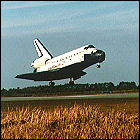 Space Shuttle Discovery lifts off on the shortest shuttle flight since the 1981 test flights, lasting only three days. A classified Defense Department payload is delivered to orbit, with the help of the first Inertial Upper Stage booster developed by the U.S. Air Force. This mission is the first time that shuttles had to be swapped out prior to flight – thermal tile issues on Challenger prevented that shuttle from being used for this mission – as well as the first instance of a shuttle launch scrubbed because of concerns over freezing weather and ice at the launch site. Discovery returns via the Kennedy Space Center runway, with Commander Ken Mattingly, Pilot Loren Shriver, mission specialists Ellison Onizuka and James Buchli, and payload specialist Gary Payton aboard.
Space Shuttle Discovery lifts off on the shortest shuttle flight since the 1981 test flights, lasting only three days. A classified Defense Department payload is delivered to orbit, with the help of the first Inertial Upper Stage booster developed by the U.S. Air Force. This mission is the first time that shuttles had to be swapped out prior to flight – thermal tile issues on Challenger prevented that shuttle from being used for this mission – as well as the first instance of a shuttle launch scrubbed because of concerns over freezing weather and ice at the launch site. Discovery returns via the Kennedy Space Center runway, with Commander Ken Mattingly, Pilot Loren Shriver, mission specialists Ellison Onizuka and James Buchli, and payload specialist Gary Payton aboard.